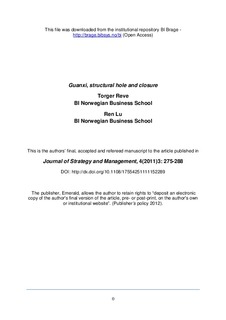Guanxi, structural hole and closure
Journal article, Peer reviewed
Permanent lenke
http://hdl.handle.net/11250/93628Utgivelsesdato
2011Metadata
Vis full innførselSamlinger
- Scientific articles [2181]
Originalversjon
10.1108/17554251111152289Sammendrag
Purpose — Understanding China’s economic success requires insights into its peculiar guanxi-based market. Many scholars are confused how to apply western network theories to the Chinese guanxi-based market. This paper contributes to this comprehensive topic by theoretically exploring the differences among three fundamental network concepts: (1) guanxi, (2) structural hole and (3) closure.
Design/methodology/approach — Following Heide (1994), we categorize a network into three dimensions: (1) network initiation, (2) network maintenance and (3) network termination, based on different time phases. We compare the three fundamental network concepts in every dimension, laying out detailed similarities and dissimilarities among them.
Findings — All three networks are initiated either naturally or artificially, but guanxi is closely embedded in the Chinese institutions. Unlike structural hole and closure, which can be applied at any level, guanxi is a special relation that only exists at the individual level. Structural hole and closure highlight networks’ structures which bring them various benefits and constrains. Such merits are not evident in guanxi in which favor exchange plays a crucial role in connecting entities. In addition, guanxi has a special rule to affect the strength of ties.
Originality/value — The purpose of this paper is to articulate the differences among guanxi, structural hole, and closure. With our systematic framework, we offer a platform to scholars who are interested in applying the western network theory to guanxi-based market, and our work also provides non-Chinese who are doing business in China with new insights.
Beskrivelse
This is the authors’ final, accepted and refereed manuscript to the article
